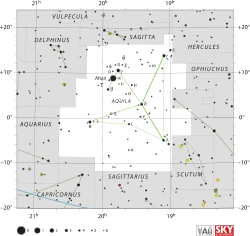Mu Aquilae
Mu Aquilae, Latinized from μ Aquilae, is the Bayer designation for a single[8] star in the equatorial constellation of Aquila. With an apparent visual magnitude of 4.45,[2] it is visible to the naked eye. The measured annual parallax shift of this star is 30.31 mas,[1] which gives a distance estimate of 107.6 light-years (33.0 parsecs) from Earth. It is drifting closer with a radial velocity of −25 km/s,[5] and displays a relatively high proper motion, traversing the celestial sphere at the rate of 0.264″ per year.[9]
 | |
| Observation data Epoch J2000 Equinox J2000 | |
|---|---|
| Constellation | Aquila |
| Right ascension | 19h 34m 05.3529s[1] |
| Declination | +07° 22′ 44.189″[1] |
| Apparent magnitude (V) | 4.45[2] |
| Characteristics | |
| Spectral type | K3-IIIb Fe0.5[3] |
| U−B color index | +1.24[2] |
| B−V color index | +1.176[4] |
| R−I color index | 0.61 |
| Astrometry | |
| Radial velocity (Rv) | −24.73±0.13[5] km/s |
| Proper motion (μ) | RA: +213.73[1] mas/yr Dec.: −156.55[1] mas/yr |
| Parallax (π) | 30.31 ± 0.24 mas[1] |
| Distance | 107.6 ± 0.9 ly (33.0 ± 0.3 pc) |
| Absolute magnitude (MV) | 1.80[5] |
| Details[6] | |
| Mass | 1.16±0.10 M☉ |
| Radius | 7.66±0.24 R☉ |
| Luminosity | 24.5 L☉ |
| Surface gravity (log g) | 2.70±0.06 cgs |
| Temperature | 4,567±79 K |
| Metallicity [Fe/H] | 0.16 dex |
| Rotational velocity (v sin i) | 0.0[4] km/s |
| Age | 6.71±2.19 Gyr |
| Other designations | |
| Database references | |
| SIMBAD | data |
The stellar classification of Mu Aquilae is K3-IIIb Fe0.5,[3] indicating that this is an evolved giant star with a mild overabundance of iron appearing in its spectrum. It belongs to a sub-category of giants called the red clump, which means it is generating energy through the fusion of helium at its core.[10] Compared to the Sun, it has 116% of the mass and has expanded to 7.7 times the size. This inflated outer envelope has an effective temperature of 4,567 K and is radiating 24.5 times the Sun's luminosity.[6] At this heat, Mu Aquilae glows with the orange hue of a K-type star.[11] It is roughly seven billion years old.[6]
References
- van Leeuwen, F. (November 2007), "Validation of the new Hipparcos reduction", Astronomy and Astrophysics, 474 (2): 653–664, arXiv:0708.1752, Bibcode:2007A&A...474..653V, doi:10.1051/0004-6361:20078357, S2CID 18759600.
- Johnson, H. L.; et al. (1966), "UBVRIJKL photometry of the bright stars", Communications of the Lunar and Planetary Laboratory, 4 (99): 99, Bibcode:1966CoLPL...4...99J.
- Keenan, Philip C.; McNeil, Raymond C. (1989), "The Perkins catalog of revised MK types for the cooler stars", The Astrophysical Journal Supplement Series, 71: 245, Bibcode:1989ApJS...71..245K, doi:10.1086/191373.
- Massarotti, Alessandro; et al. (January 2008), "Rotational and Radial Velocities for a Sample of 761 HIPPARCOS Giants and the Role of Binarity", The Astronomical Journal, 135 (1): 209–231, Bibcode:2008AJ....135..209M, doi:10.1088/0004-6256/135/1/209, S2CID 121883397.
- Hekker, S.; et al. (August 2006), "Precise radial velocities of giant stars. I. Stable stars", Astronomy and Astrophysics, 454 (3): 943–949, arXiv:astro-ph/0604502, Bibcode:2006A&A...454..943H, doi:10.1051/0004-6361:20064946, S2CID 119529768
- Maldonado, J.; et al. (June 2013), "The metallicity signature of evolved stars with planets", Astronomy & Astrophysics, 554: 18, arXiv:1303.3418, Bibcode:2013A&A...554A..84M, doi:10.1051/0004-6361/201321082, S2CID 119289111, A84.
- "* mu. Aql", SIMBAD, Centre de données astronomiques de Strasbourg, retrieved 2012-07-18.
- Eggleton, Peter; Tokovinin, A. (2008), "A catalogue of multiplicity among bright stellar systems", Monthly Notices of the Royal Astronomical Society, 389 (2): 869, arXiv:0806.2878, Bibcode:2008MNRAS.389..869E, doi:10.1111/j.1365-2966.2008.13596.x, S2CID 14878976.
- Lépine, Sébastien; Shara, Michael M. (March 2005), "A Catalog of Northern Stars with Annual Proper Motions Larger than 0.15" (LSPM-NORTH Catalog)", The Astronomical Journal, 129 (3): 1483–1522, arXiv:astro-ph/0412070, Bibcode:2005AJ....129.1483L, doi:10.1086/427854, S2CID 2603568.
- Alves, David R. (August 2000), "K-Band Calibration of the Red Clump Luminosity", The Astrophysical Journal, 539 (2): 732–741, arXiv:astro-ph/0003329, Bibcode:2000ApJ...539..732A, doi:10.1086/309278, S2CID 16673121.
- "The Colour of Stars", Australia Telescope, Outreach and Education, Commonwealth Scientific and Industrial Research Organisation, December 21, 2004, archived from the original on March 18, 2012, retrieved 2012-01-16.